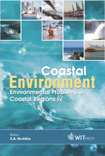Effects Of Seepage Flows On Sediment Transport Rates
Price
Free (open access)
Transaction
Volume
58
Pages
Published
2002
Size
405 kb
Paper DOI
10.2495/CENV020421
Copyright
WIT Press
Author(s)
C O’Donnell, B A O’Connor & K H M Ali
Abstract
Effect of seepage flows on sediment transport rates C. O’Donnell1, B.A. O’Connor2 and K.H.M. Ali2 1Tessella Support Services, U.K. 2Department of Civil Engineering, University of Liverpool, U.K. Abstract Previous work on the effect of seepage force through a sediment bed has indicated that there is likely to be little effect upon sediment transport rates. This paper describes results from preliminary laboratory tests on the effect of increasing levels of seepage flow from a sand bed on bed load transport rates. Experiments were carried out in a 300 mm wide, 460 mm deep rectangular cross section re-circulating flow channel of 10m length. Seepage flows were introduced via a side chamber of 360 mm length in the central part of the flume in which a sand bed were placed with d50=250pm. Velocities, turbulence and shear stress profiles over the water column were measured using a 3D acoustic velocity probe while sediment quantities were obtained by direct trapping of material at the end of the flume. The results indicated that at low seepage rates the transport of material is marginally (<5%) reduced, that effects are equally small at seepage rates up to some 70-80% of those required for bed failure. However, at bed failure due to upward seepage flow, the bed load transport rate can increase by some 200-300%. The results have important implications for the study of scour around coastal structures. 1 Introduction In the field of coastal engineering seabed erosion can be a serious problem. As the seabed forms an integral part of offshore or nearshore structures’ foundations, any weakening can have potentially disastrous effects. Consider, for example, theKeywords





